Cell - the unit of life MCQ Solved Paper for GMAT
Thursday 9th of March 2023

Sharing is caring
1. Which of the following pair lack the unit membrane?
A. Nucleus and E.R.
B. Mitochondria and chloroplast
C. Ribosome and nucleolus
D. Golgi body and lysosome
Answer : C
A. Nucleus and E.R.
B. Mitochondria and chloroplast
C. Ribosome and nucleolus
D. Golgi body and lysosome
Answer : C
2. Prokaryotic and eukaryotic flagella differ in the
A. type of movement and placement.
B. location and mode of functioning.
C. microtubular structure and function.
D. microtubular organization and type of movement.
Answer : D
A. type of movement and placement.
B. location and mode of functioning.
C. microtubular structure and function.
D. microtubular organization and type of movement.
Answer : D
3. Chromosomes having equal or almost equal arms are called
A. metacentric
B. acrocentric
C. polycentric
D. acentric.
Answer : A
A. metacentric
B. acrocentric
C. polycentric
D. acentric.
Answer : A
4. Consider the following statements and choose the correct statement.
A. (i) and (iii)
B. (ii) and (iv)
C. (iii) and (iv)
D. (ii) and (iii)
Answer : D
- The endomembrane system includes mitochondria, chloroplast and peroxisomes.
- Smooth endoplasmic reticulum is the major site for synthesis of lipid.
- Rough endoplasmic reticulum is actively involved in protein synthesis.
- Mitochondrial matrix possesses single circular DNA, a few RNA and 80S ribosomes. Of the above statements.
A. (i) and (iii)
B. (ii) and (iv)
C. (iii) and (iv)
D. (ii) and (iii)
Answer : D
5. In prokaryotes, chromatophores are
A. specialized granules responsible for colouration of cells
B. structures responsible for organizing the shape of the organism.
C. inclusion bodies lying free inside the cells for carrying out various metabolic activities.
D. internal membrane system which becomes extensive and complex in photosynthetic bacteria.
Answer : D
A. specialized granules responsible for colouration of cells
B. structures responsible for organizing the shape of the organism.
C. inclusion bodies lying free inside the cells for carrying out various metabolic activities.
D. internal membrane system which becomes extensive and complex in photosynthetic bacteria.
Answer : D
6. Function of contractile vacuole in Amoeba is
A. excretion and osmoregulation.
B. digestion and respiration.
C. osmoregulation and transportation.
D. none of the above.
Answer : A
A. excretion and osmoregulation.
B. digestion and respiration.
C. osmoregulation and transportation.
D. none of the above.
Answer : A
7. Match column-I (scientists) with column-II (discovery) and select the correct option.
A. A I, B III, C IV, D II
B. A I, B III, C II, D IV
C. A III, B I, C IV, D II
D. A I, B IV, C II, D III
Answer : A
| Column-I | Column-II |
|---|---|
| A. Leeuwenhoek | I. First saw and described a living cell |
| B. Robert Brown | II. Presence of cell wall is unique to plant cells |
| C. Schleiden | III. Discovered the nucleus |
| D. Schwann | IV. All plants are composed of different kind of cells |
A. A I, B III, C IV, D II
B. A I, B III, C II, D IV
C. A III, B I, C IV, D II
D. A I, B IV, C II, D III
Answer : A
8. The following diagram shows some of the missing structures in a plant cell marked as A, B, C, D E. Choose the option with their correct names.
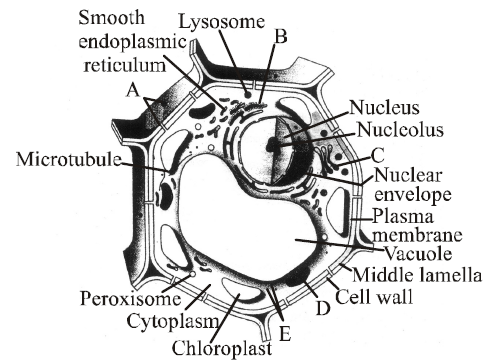
A. A - Plasmodesmata, B - Rough endoplasmic reticulum, C - Golgi apparatus, D - Mitochondrion, E - Ribosomes
B. A - Desmosome, B - Rough endoplasmic reticulum, C - Golgi apparatus, D - Mitochondrion, E - Ribosomes
C. A - Plasmodesmata, B - Smooth endoplasmic reticulum, C - Golgi apparatus, D - Mitochondrion, E - Ribosomes
D. A - Tight junction, B - Rough endoplasmic reticulum, C - Golgi apparatus, D - Mitochondrion, E -Ribosomes
Answer : A

A. A - Plasmodesmata, B - Rough endoplasmic reticulum, C - Golgi apparatus, D - Mitochondrion, E - Ribosomes
B. A - Desmosome, B - Rough endoplasmic reticulum, C - Golgi apparatus, D - Mitochondrion, E - Ribosomes
C. A - Plasmodesmata, B - Smooth endoplasmic reticulum, C - Golgi apparatus, D - Mitochondrion, E - Ribosomes
D. A - Tight junction, B - Rough endoplasmic reticulum, C - Golgi apparatus, D - Mitochondrion, E -Ribosomes
Answer : A
9. Identify the cell organelle given below. Which is an important site of formation of glyeoproteins & glycolipids
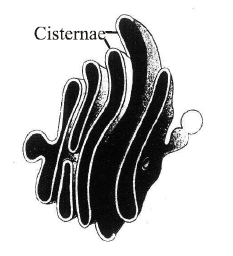
A. Rough endoplasmic reticulum
B. Smooth endoplasmic reticulum
C. Golgi body
D. mitochondria
Answer : C

A. Rough endoplasmic reticulum
B. Smooth endoplasmic reticulum
C. Golgi body
D. mitochondria
Answer : C
10. Which of the following statement is false?
A. The ribosomes of a polysome translate the mRNA into protein.
B. Mitochondria divide by fragmentation.
C. All cell arise from pre-existing cells.
D. The lipid component of the membrane mainly consists of phosphoglycerides.
Answer : B
A. The ribosomes of a polysome translate the mRNA into protein.
B. Mitochondria divide by fragmentation.
C. All cell arise from pre-existing cells.
D. The lipid component of the membrane mainly consists of phosphoglycerides.
Answer : B
11. Which of the following statements is/are correct ?
A. (i), (ii), (iii) and (iv)
B. Only (i) and (ii)
C. Only (iv)
D. None of the above
Answer : A
- The shape of the cells may vary with the function they perform.
- Human RBC is about 7.0 ??m in diameter.
- Cytoplasm is the main area of cellular activities.
- Various chemical reactions occur in cytoplasm to keep the cell in the living state.
A. (i), (ii), (iii) and (iv)
B. Only (i) and (ii)
C. Only (iv)
D. None of the above
Answer : A
12. Function of RER is
A. autolysis
B. protein synthesis
C. lipid synthesis
D. carbohydrate synthesis
Answer : B
A. autolysis
B. protein synthesis
C. lipid synthesis
D. carbohydrate synthesis
Answer : B
13. Which one of the following cellular parts is correctly matched with their characters ?
A. Centrioles Sites for active RNA synthesis.
B. Lysosomes Optimally active at a pH of about 8.5.
C. Thylakoids Flattened membranous sacs forming the grana of chloroplasts.
D. Ribosomes Those on chloroplasts are larger (80S) while those in the cytoplasm are smaller (70S).
Answer : C
A. Centrioles Sites for active RNA synthesis.
B. Lysosomes Optimally active at a pH of about 8.5.
C. Thylakoids Flattened membranous sacs forming the grana of chloroplasts.
D. Ribosomes Those on chloroplasts are larger (80S) while those in the cytoplasm are smaller (70S).
Answer : C
14. The main organelle involved in modification and routing of newly synthesized proteins to their destinations is
A. chloroplast
B. mitochondria
C. lysosome
D. endoplasmic reticulum
Answer : D
A. chloroplast
B. mitochondria
C. lysosome
D. endoplasmic reticulum
Answer : D
15. What would happen if lysosomes get ruptured in a cell?
A. Cell dies
B. Cell shrinks
C. Cell swell up
D. Nothing would happen
Answer : A
A. Cell dies
B. Cell shrinks
C. Cell swell up
D. Nothing would happen
Answer : A
16. Select the statements which are related to Schwann.
A. Only ()
B. Only (iii)
C. (i) and (iii)
D. All of these
Answer : D
- He reported that cells have a thin outer layer which is today known as plasma membrane
- Cell wall is a unique character of the plant cell.
- Body of plants and animals are composed of cells and products of cells.
A. Only ()
B. Only (iii)
C. (i) and (iii)
D. All of these
Answer : D
17. The cytoskeleton is a proteinaceous network of fibres in the cytoplasm. It is involved in
A. mechanical support.
B. motility.
C. maintenace of cell-shape.
D. all of the above
Answer : D
A. mechanical support.
B. motility.
C. maintenace of cell-shape.
D. all of the above
Answer : D
18. Which of the following is incorrect ?
A. Mycoplasma is the smallest cell (0.3 �).
B. Bacteria are 3 to 5 �m in size.
C. The largest cell is the egg of an ostrich.
D. Nerve cells are some of the smallest cells.
Answer : D
A. Mycoplasma is the smallest cell (0.3 �).
B. Bacteria are 3 to 5 �m in size.
C. The largest cell is the egg of an ostrich.
D. Nerve cells are some of the smallest cells.
Answer : D
19. Which one of the following organelle given below is correctly matched with its function ?
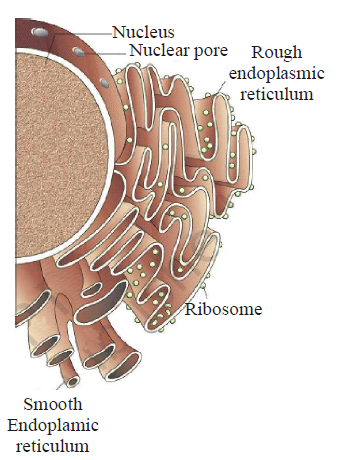
A. Golgi apparatus Protein synthesis
B. Golgi apparatus Formation of glycolipids
C. Rough endoplasmic reticulum Protein synthesis
D. Rough endoplasmic reticulum Formation of glycoproteins
Answer : C

A. Golgi apparatus Protein synthesis
B. Golgi apparatus Formation of glycolipids
C. Rough endoplasmic reticulum Protein synthesis
D. Rough endoplasmic reticulum Formation of glycoproteins
Answer : C
20. Which one of the following combination is mismatched?
A. Glycocalyx May be capsule or slime layer
B. Pili Reproduction
C. Cell wall Protective, determines shape, prevents from bursting
D. Flagella, pili and fimbriae Surface structures of bacterial cell
Answer : B
A. Glycocalyx May be capsule or slime layer
B. Pili Reproduction
C. Cell wall Protective, determines shape, prevents from bursting
D. Flagella, pili and fimbriae Surface structures of bacterial cell
Answer : B
21. Statement 1: Centrosomes and centrioles are related to each other.
Statement 2: Centrosome usually contains two cylindrical structures called centrioles.
A. Both statements -1 and statement - 2 are true and statement - 2 is the correct explanation of statement - 1.
B. Both statements -1 and statement - 2 are true but statement - 2 is not the correct explanation of statement - 1.
C. Statement -1 is true and statement - 2 is false.
D. Statement -1 is false and statement - 2 is true.
Answer : A
Statement 2: Centrosome usually contains two cylindrical structures called centrioles.
A. Both statements -1 and statement - 2 are true and statement - 2 is the correct explanation of statement - 1.
B. Both statements -1 and statement - 2 are true but statement - 2 is not the correct explanation of statement - 1.
C. Statement -1 is true and statement - 2 is false.
D. Statement -1 is false and statement - 2 is true.
Answer : A
22. Golgi apparatus is absent in
A. higher plants
B. yeast
C. bacteria and blue-green algae
D. None of the above
Answer : C
A. higher plants
B. yeast
C. bacteria and blue-green algae
D. None of the above
Answer : C
23. Which of the following statement is correct regarding vacuole?
A. It is membrane-bound and contains storage proteins and lipids.
B. It is membrane-bound and contains water and excretory substances.
C. It lacks membrane and contains air.
D. It lacks membrane and contains water and excretory substances.
Answer : B
A. It is membrane-bound and contains storage proteins and lipids.
B. It is membrane-bound and contains water and excretory substances.
C. It lacks membrane and contains air.
D. It lacks membrane and contains water and excretory substances.
Answer : B
24. Which of the following organelles is directly connected to the outer membrane of the nucleus in a eukaryotic cell?
A. Mitochondrion
B. Lysosome
C. Golgi apparatus
D. Endoplasmic reticulum
Answer : D
A. Mitochondrion
B. Lysosome
C. Golgi apparatus
D. Endoplasmic reticulum
Answer : D
25. Which of the following statements are correct ?
A. (iii) and (iv)
B. (i) and (ii)
C. (ii) and (iii)
D. (i) and (iv)
Answer : A
- In prokaryotic cells, a special membranous structure formed by the extension of the plasma membrane into the cell is known as polysome.
- The smooth endoplasmic reticulum is the major site for synthesis of glycoproteins.
- RuBisCO is the most abundant protein in the whole biosphere.
- Mitochondria, chloroplasts and peroxisomes are not considered as part of endomembrane system. Of the above statements
A. (iii) and (iv)
B. (i) and (ii)
C. (ii) and (iii)
D. (i) and (iv)
Answer : A
26. Lysosomes contain
A. carbohydrates
B. hormones
C. nucleic acids
D. hydrolases.
Answer : D
A. carbohydrates
B. hormones
C. nucleic acids
D. hydrolases.
Answer : D
27. Which one of the following structures between two adjacent cells is an effective transport pathway?
A. Plasmodesmata
B. Plastoquinones
C. Endoplasmic reticulum
D. Plasmalemma
Answer : A
A. Plasmodesmata
B. Plastoquinones
C. Endoplasmic reticulum
D. Plasmalemma
Answer : A
28. Match column-I with column-II and select the correct option.
A. A - IV, B - V, C - I, D - II
B. A - I, B - II, C - IV, D - III
C. A - IV, B - I, C - II, D - III
D. A - I, B - II, C - III, D - IV
Answer : A
| Column - I | Column - II |
|---|---|
| A. Golgi apparatus | I. Storage |
| B. Mitochondria | II. Photosynthesis |
| C. Vacuoles | III. Transport |
| D. Grana | IV. Secretion |
| .. | V. Respiration |
A. A - IV, B - V, C - I, D - II
B. A - I, B - II, C - IV, D - III
C. A - IV, B - I, C - II, D - III
D. A - I, B - II, C - III, D - IV
Answer : A
29. Golgi apparatus is concerned with
A. excretion
B. secretion
C. ATP synthesis
D. RNA synthesis
Answer : A
A. excretion
B. secretion
C. ATP synthesis
D. RNA synthesis
Answer : A
30. Which of the following statement of a bacterial cell is/are correct?
A. (i), (ii), (iii)
B. All of the above
C. (ii) & (iv)
D. None of the above
Answer : A
- Mesosome is formed by the extensions of plasma membrane into the cell.
- The pili are elongated tubular structures made up of a protein.
- Flagellum is composed of filament, hook and basal body.
- Ribosomes are about 30 nm by 50 nm in size.
A. (i), (ii), (iii)
B. All of the above
C. (ii) & (iv)
D. None of the above
Answer : A
31. 8.A student was given cell samples (A and B) to identify parts which are highlighted. He observed the samples under the microscope and list down the function of the part of cell sample. The information collected by the student is listed in the table below, on the basis of which the student infers that the samples contain the organelles.
Identify the part highlighted in the sample A and B and explain why they were called as semi-autonomous organelles?
A. Sample A - Mitochondria, Sample B - Chloroplast; because both the organelles are double membrane bound structure.
B. Sample A- Mitochondria, Sample B - Chloroplast; because they both are capable of synthesis of their own proteins only.
C. Sample A - Mitocondria, Sample B - Chloroplast; because they are capable of synthesis of their own proteins and contain their own DNA.
D. Sample A- Mitochondria, Sample B - Chloroplast; because they contain their own DNA to transfer the genetic information from one generation to another.
Answer : C
| Sample A | Sample B |
|---|---|
| Make energy available for cellular metabolism | Generates ATP and synthes izes s ugar |
| Absent in cell that carry oxygen throughout the body | Present in plant cell |
| Called the energy currency of cell | Source o f all the food energy |
Identify the part highlighted in the sample A and B and explain why they were called as semi-autonomous organelles?
A. Sample A - Mitochondria, Sample B - Chloroplast; because both the organelles are double membrane bound structure.
B. Sample A- Mitochondria, Sample B - Chloroplast; because they both are capable of synthesis of their own proteins only.
C. Sample A - Mitocondria, Sample B - Chloroplast; because they are capable of synthesis of their own proteins and contain their own DNA.
D. Sample A- Mitochondria, Sample B - Chloroplast; because they contain their own DNA to transfer the genetic information from one generation to another.
Answer : C
32. Match column-I (cell organelle) with column-II membrane and select the correct option from the codes given below.
A. A - I, B - II, C - III
B. A - III, B - I, C - II
C. A - III, B - II, C - I
D. A - II, B - III, C - I
Answer : C
| Column-I | Column-II |
|---|---|
| A. Mitochondria | I. Without membrane |
| B. Lysosomes | II. Single membrane |
| C. Ribosomes | III. Double membrane |
A. A - I, B - II, C - III
B. A - III, B - I, C - II
C. A - III, B - II, C - I
D. A - II, B - III, C - I
Answer : C
33. Match column-I with column-II and select the correct option.
A. A III, B II, C IV, D I
B. A II, B III, C IV, D I
C. A I, B III, C II, D IV
D. A IV, B II, C III, D I
Answer : A
| Column - I | Column - II |
|---|---|
| A. RER | I. Intracellular and extracellular digestion |
| B. Cell wall | II. Provide structural support to the cell |
| C. Flagella | III. Protein synthesis and secretion |
| D. Lysosomes | IV Responsible for cell movement |
A. A III, B II, C IV, D I
B. A II, B III, C IV, D I
C. A I, B III, C II, D IV
D. A IV, B II, C III, D I
Answer : A
34. Which of the following is absent in prokaryotes?
A. DNA
B. RNA
C. Plasma membrane
D. Mitochondria
Answer : D
A. DNA
B. RNA
C. Plasma membrane
D. Mitochondria
Answer : D
35. Who proposed the theory that Cells arise only from the pre-existing cells?
A. Mohl
B. Virchow
C. Haeckel
D. Brown
Answer : B
A. Mohl
B. Virchow
C. Haeckel
D. Brown
Answer : B
36. Microtubules are absent in
A. mitochondria
B. centriole
C. flagella
D. spindle fibres
Answer : A
A. mitochondria
B. centriole
C. flagella
D. spindle fibres
Answer : A
37. The following diagram represents a structure chromosome.
Identify the structures marked as A, B and C.
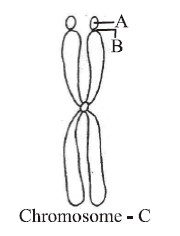
A. A - Satellite, B - Primary constriction, C - Acrocentric
B. A - Satellite, B - Secondary constriction, C - Metacentric
C. A - Satellite, B - Centromere, C - Telocentric
D. A - Satellite, B - Centromere, C - Submetacentric
Answer : B
Identify the structures marked as A, B and C.

A. A - Satellite, B - Primary constriction, C - Acrocentric
B. A - Satellite, B - Secondary constriction, C - Metacentric
C. A - Satellite, B - Centromere, C - Telocentric
D. A - Satellite, B - Centromere, C - Submetacentric
Answer : B
38. Basal bodies are associated with the formation of
A. phragmoplast
B. cilia and flagella
C. cell plate
D. kinetochore
Answer : B
A. phragmoplast
B. cilia and flagella
C. cell plate
D. kinetochore
Answer : B
39. The best material for study of structure of cell membrane is
A. RBC of human
B. RBC of frog
C. cheek cell of human
D. liver cell of rat
Answer : A
A. RBC of human
B. RBC of frog
C. cheek cell of human
D. liver cell of rat
Answer : A
40. A component of cytoskeleton is
A. microtubule
B. bone
C. chitin
D. cartilage.
Answer : A
A. microtubule
B. bone
C. chitin
D. cartilage.
Answer : A
41. 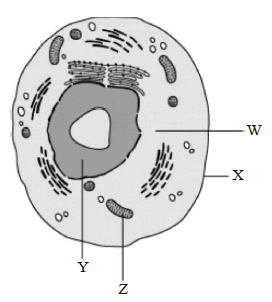
Which cellular structure helps in transferring genetic information from one generation to another?
A. W
B. X
C. Y
D. Z
Answer : C

Which cellular structure helps in transferring genetic information from one generation to another?
A. W
B. X
C. Y
D. Z
Answer : C
42. Both the membranes of mitochondrion are
A. structurally different but functionally similar.
B. structurally as well as functionally different.
C. structurally similar but functionally different.
D. structurally different but functionally similar.
Answer : B
A. structurally different but functionally similar.
B. structurally as well as functionally different.
C. structurally similar but functionally different.
D. structurally different but functionally similar.
Answer : B
43. Integral proteins of cell membrane occur on/in
A. inner surfaces
B. outer surfaces
C. phospholipid matrix
D. inner and outer surfaces
Answer : D
A. inner surfaces
B. outer surfaces
C. phospholipid matrix
D. inner and outer surfaces
Answer : D
44. Cell sap is a
A. living content of cytoplasm.
B. nonliving content of cytoplasm.
C. nonliving content of vacuole.
D. living content of vacuole.
Answer : C
A. living content of cytoplasm.
B. nonliving content of cytoplasm.
C. nonliving content of vacuole.
D. living content of vacuole.
Answer : C
45. Match column-I with column-II and choose the correct option.
A. A IV; B III; C I; D II
B. A II; B III; C IV; D I
C. A IV; B II; C III; D I
D. A I; B III; C II; D IV
Answer : A
| Column-I | Column-II |
|---|---|
| A. Tonoplast | I. Contain digestive enzyme |
| B. Contractile vacuole | II. Store metabolic gases |
| C. Food vacuole | III. Excretion |
| D. Air vacuole | IV. Transport of ions in plants |
A. A IV; B III; C I; D II
B. A II; B III; C IV; D I
C. A IV; B II; C III; D I
D. A I; B III; C II; D IV
Answer : A
46. According to widely accepted fluid mosaic model cell membranes are semi-fluid, where lipids and integral proteins can diffuse randomly. In recent years, this model has been modified in several respects. In this regard, which of the following statements is incorrect?
A. Proteins in cell membranes can travel within the lipid bilayer.
B. Proteins can also undergo flip-flop movements in the lipid bilayer.
C. Proteins can remain confined within certain domains of the membrane.
D. Many proteins remain completely embedded within the lipid bilayer.
Answer : B
A. Proteins in cell membranes can travel within the lipid bilayer.
B. Proteins can also undergo flip-flop movements in the lipid bilayer.
C. Proteins can remain confined within certain domains of the membrane.
D. Many proteins remain completely embedded within the lipid bilayer.
Answer : B
47. Match column-I with column-II and choose the correct option.
A. A III; B IV; C II; D I
B. A IV; B III; C II; D I
C. A I; B II; C III; D IV
D. A IV; B III; C I ; D II
Answer : A
| Column-I | Column-II |
|---|---|
| (Chromosome) | (Position of Centromere) |
| A. Metacentric | I. At the tip |
| B. Submetacentric | II. Almost near the tip |
| C. Acrocentric | III. At the middle |
| D. Telocentric | IV. Slightly away from the middle |
A. A III; B IV; C II; D I
B. A IV; B III; C II; D I
C. A I; B II; C III; D IV
D. A IV; B III; C I ; D II
Answer : A

Select the part correctly matched with its function.
A. Part (D): Outer membrane Gives rise to inner membrane by splitting.
B. Part (B): Inner membrane Forms infoldings called cristae.
C. Part (C): Cristae Possess single circular DNA molecule and ribosomes.
D. Part (A): Matrix Major site for respiratory chain enzymes.
Answer : B
49. In the given figure of animal cell, one orginelle is marked as A. Select the correct identification and function of the organelle A from the given option.
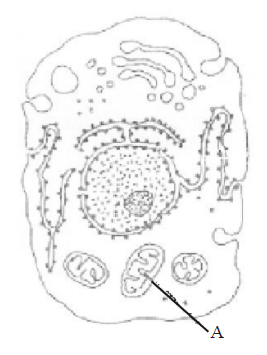
A. Endoplasmic reticulum Synthesis of lipids.
B. Mitochondria Produce cellular energy in the form of ATP.
C. Golgi body Provides packaging material.
D. Lysosomes Secrete hydrolytic enzymes.
Answer : B

A. Endoplasmic reticulum Synthesis of lipids.
B. Mitochondria Produce cellular energy in the form of ATP.
C. Golgi body Provides packaging material.
D. Lysosomes Secrete hydrolytic enzymes.
Answer : B
50. Plastids storing fat are called
A. Elaioplasts
B. Sphaerosomes
C. Aleuroplasts
D. Pyrenoids
Answer : A
A. Elaioplasts
B. Sphaerosomes
C. Aleuroplasts
D. Pyrenoids
Answer : A
Sharing is caring
Related Post
Advance DBMS 1000+ MCQ with answer for CTET
Radiologic Examination MCQ Solved Paper for GRE
Internal Combustion MCQ Solved Paper for SSC JHT
1000+ Current Affairs July 2017 MCQ for RBI Assistant [Solved]
Manufacturing & Production Engineering 1000+ MCQ with answer for CEED
1000+ Current Affairs May 2017 MCQ for CAT [Solved]